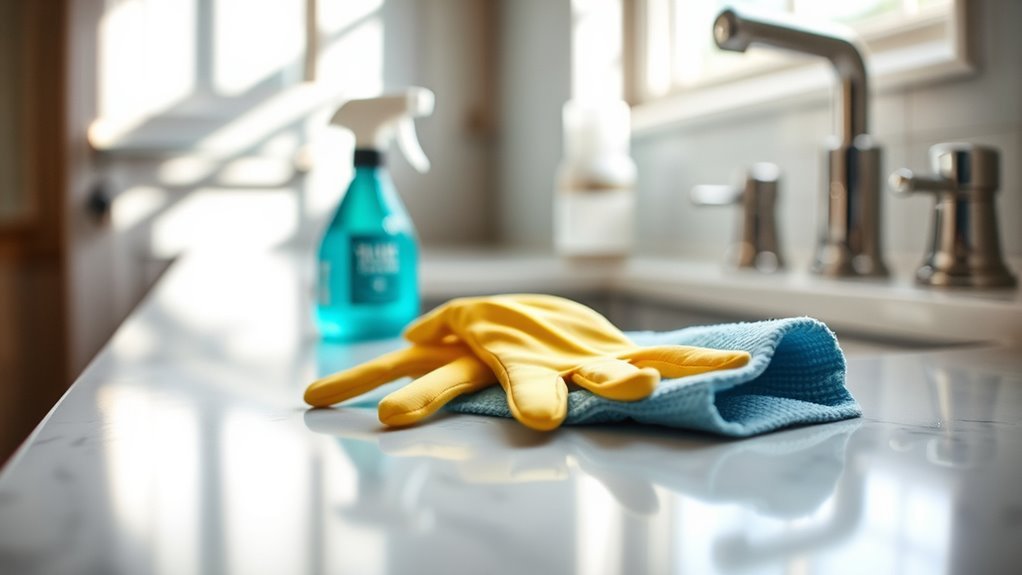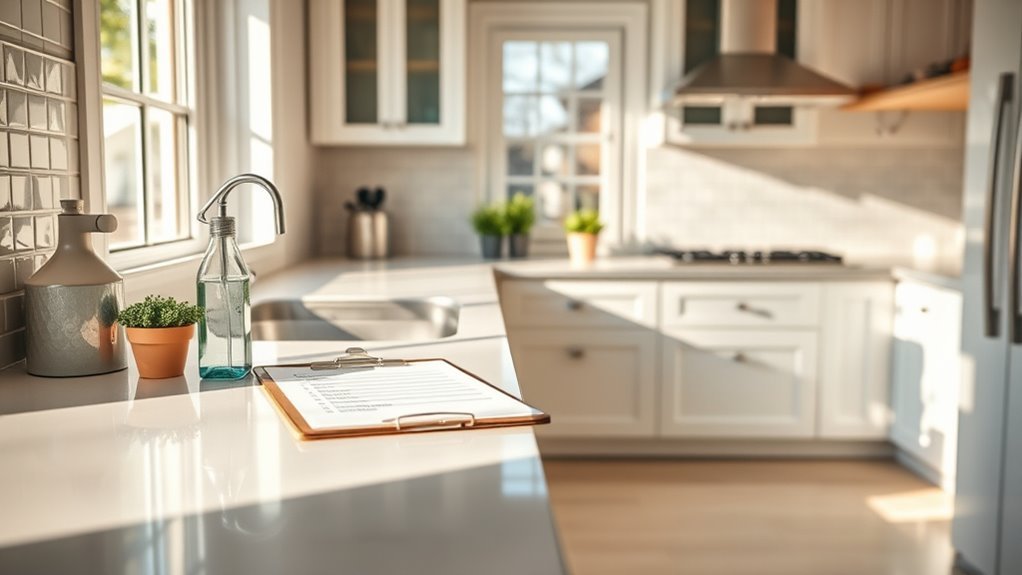Deep Cleaning Checklist for Germs
To deep clean for germs effectively, focus on disinfecting high-touch surfaces like doorknobs, light switches, and faucet handles daily using EPA-approved agents suited for your materials. Use microfiber cloths and HEPA-filter vacuums for precise cleaning, and follow disinfectant dwell times carefully. Tailor techniques to rooms—sanitize kitchens with pH-neutral cleaners, and control moisture in bathrooms. Maintaining tool hygiene and monitoring air quality post-cleaning guarantees lasting results. Keep exploring to optimize your germ control strategy further.
Identifying High-Touch Surfaces to Prioritize

When deep cleaning, you’ll want to focus on the top five high-touch surfaces that can harbor the most germs: doorknobs, light switches, countertops, faucet handles, and remote controls. These high touch items demand your immediate attention because their frequent contact increases contamination risk. Establishing a proper cleaning frequency is vital; daily disinfection is recommended in high-traffic areas to minimize microbial buildup. Prioritize surfaces based on usage patterns and exposure, adjusting your schedule to maintain a consistently low pathogen presence. By identifying and targeting these critical points, you not only reduce infection vectors but also reclaim control over your environment. This precision in selecting and timing your cleaning efforts guarantees maximum effectiveness without unnecessary labor, granting you the freedom to focus on what matters most.
Choosing the Right Cleaning Agents and Disinfectants
Identifying high-touch surfaces sets the stage for selecting the most effective cleaning agents and disinfectants tailored to those specific areas. To maintain your freedom from harmful residues and damage, prioritize surface compatibility when choosing products. You want agents that thoroughly disinfect without compromising materials. Eco friendly options offer powerful germ elimination with reduced environmental impact, aligning with sustainable practices.
Choosing surface-compatible, eco-friendly disinfectants ensures effective cleaning without damage or harmful residues.
Consider these factors when selecting your cleaning agents:
- Material sensitivity: Use disinfectants safe for metals, plastics, or wood.
- EPA registration: Confirm efficacy against targeted pathogens.
- Residue and odor: Opt for low-residue formulas to avoid buildup and unpleasant smells.
Step-by-Step Deep Cleaning Process for Germ Elimination

To effectively eliminate germs, you’ll need essential cleaning supplies like EPA-approved disinfectants, microfiber cloths, and gloves. Focus your efforts on targeted germ hotspots such as doorknobs, light switches, and faucet handles. Following a systematic step-by-step process guarantees thorough sanitation and minimizes contamination risks.
Essential Cleaning Supplies
Effective germ elimination starts with selecting the right cleaning supplies tailored to your deep cleaning needs. You want products that deliver potent disinfection while respecting your health and budget constraints. Prioritize eco friendly supplies to reduce chemical exposure and environmental impact without sacrificing efficacy. At the same time, consider budget friendly options that provide reliable germ-killing power without overspending.
Key essentials include:
- EPA-registered disinfectants proven to eradicate a broad spectrum of pathogens
- Microfiber cloths designed for peak particle capture and surface compatibility
- Protective gloves to safeguard your skin during chemical application
Targeted Germ Hotspots
Now that you’ve gathered the right cleaning supplies, focusing on areas where germs most frequently accumulate will maximize your efforts. Targeted germ hotspots include door handles, light switches, faucet handles, and electronic devices—these surfaces enable rapid germ transmission due to frequent contact. Pay special attention to kitchen and bathroom areas, where moisture accelerates microbial growth. Establish a cleaning frequency aligned with usage patterns; high-touch surfaces demand daily disinfection, while less-used areas can be addressed weekly. Use EPA-approved disinfectants and follow manufacturer instructions for dwell time to guarantee effectiveness. By systematically addressing these critical zones with consistent cleaning frequency, you greatly reduce pathogen reservoirs, breaking germ transmission cycles. This targeted approach offers you freedom from persistent contamination, enhancing both hygiene and health in your environment.
Effective Cleaning Techniques for Different Room Types
You’ll need specific techniques to tackle each room effectively. In the kitchen, focus on disinfecting surfaces where bacteria thrive, while in the bathroom, prioritize eliminating germs from high-touch areas. For the living room, control dust accumulation with targeted cleaning methods to maintain air quality and surface cleanliness.
Kitchen Surface Disinfection
Although kitchen surfaces vary widely in material and usage, disinfecting them properly is crucial to prevent cross-contamination and foodborne illnesses. When you tackle kitchen surface disinfection, focus on countertop material considerations—granite, laminate, and stainless steel each require specific cleaning agents to maintain integrity while eliminating germs. Don’t overlook kitchen appliances sanitization; handles, buttons, and touchscreens harbor bacteria and need targeted disinfecting with EPA-approved solutions.
To guarantee thorough disinfection, follow these steps:
- Use a pH-neutral cleaner on sensitive countertops to avoid damage.
- Apply disinfectant sprays uniformly, allowing proper dwell time.
- Sanitize high-touch appliance areas daily to minimize microbial presence.
Bathroom Germ Elimination
Moving from kitchen surfaces to bathroom environments, the approach to germ elimination must adapt to the distinct materials and usage patterns found in various bathroom types. For effective toilet sanitation, use EPA-registered disinfectants that target bacteria and viruses, applying them under the rim and on all touchpoints. Pay special attention to flushing mechanisms and handle areas, as these harbor high germ concentrations. Mold prevention requires controlling moisture by thoroughly drying tiles and grout after cleaning. Incorporate mold-inhibiting solutions on porous surfaces to disrupt fungal growth. Ventilation is critical—ensure fans or windows reduce humidity promptly. By tailoring your cleaning technique to the bathroom’s unique fixtures and environmental conditions, you maintain hygienic freedom, minimizing pathogen presence and mold proliferation efficiently without compromising surface integrity or air quality.
Living Room Dust Control
When controlling dust in your living room, understanding the different surfaces and materials involved is essential for effective cleaning. Dust accumulates not only on solid surfaces but also within furniture fabric, impacting air quality. To maintain a dust-free environment and promote healthier air, you need tailored approaches.
- Use a vacuum with a HEPA filter on upholstery to extract embedded dust from furniture fabric.
- Microfiber cloths efficiently trap dust on hard surfaces without dispersing particles into the air.
- Regularly replace or clean air filters in HVAC systems to reduce airborne dust and allergens.
Tools and Equipment Essential for Deep Cleaning
Five essential tools and pieces of equipment form the foundation of an effective deep cleaning process. You’ll need a high-efficiency vacuum cleaner with HEPA filtration to capture microscopic particles, microfiber cloths for precise surface cleaning, a steam cleaner to eliminate stubborn germs, disinfectant sprays with proven efficacy, and a sturdy mop system for floors. Prioritize cleaning organization by storing tools systematically, ensuring easy access and reducing downtime. Regular equipment maintenance is vital—inspect filters, replace worn parts, and sanitize tools after each use to maintain performance and prevent cross-contamination. By mastering these essentials, you empower yourself with the freedom to execute deep cleaning tasks efficiently and thoroughly, safeguarding your environment against harmful germs without unnecessary complexity or delay.
Maintaining a Germ-Free Environment Post-Cleaning

Although thorough cleaning removes most contaminants, maintaining a germ-free environment post-cleaning requires consistent adherence to best practices. Your post cleaning maintenance should involve systematic strategies to prevent recontamination and uphold hygiene standards. Implement ongoing sanitation protocols that are both effective and efficient, empowering you to stay in control of your space.
Key actions include:
- Regularly disinfect high-touch surfaces with EPA-approved agents to inhibit microbial resurgence.
- Confirm proper ventilation to reduce airborne pathogens and maintain air quality.
- Monitor and replace cleaning tools routinely to avoid cross-contamination.
Frequently Asked Questions
How Often Should Deep Cleaning Be Scheduled for Homes With Pets?
Imagine dusting your home with a feather duster from the Victorian era—quaint but ineffective today. For homes with pets, your deep cleaning frequency should be at least once every two weeks to adequately manage pet hair and dander buildup. Regular pet hair management reduces allergens and maintains air quality, giving you freedom from constant sneezing and irritation. Combining vacuuming with steam cleaning guarantees a thorough cleanse, preserving your home’s fresh, healthy environment.
Are Natural or Homemade Disinfectants Effective Against Germs?
When evaluating homemade remedies, you should consider disinfectant efficacy carefully. Many natural solutions, like vinegar or hydrogen peroxide, can reduce some germs but aren’t as consistently effective as commercial disinfectants against all pathogens. If you want freedom from harsh chemicals, you can use these remedies for light cleaning, but for thorough germ elimination, especially in high-risk areas, relying solely on homemade disinfectants might not provide the extensive protection you need.
Can UV Light Be Safely Used for Germ Elimination at Home?
Imagine a beam of intense violet light sweeping over surfaces, zapping unseen germs with precision. UV effectiveness in germ elimination is scientifically proven, as it disrupts microbial DNA. However, you must follow strict safety precautions—never expose your skin or eyes directly to UV light, as it can cause harm. Using UV devices designed for home use, with proper handling, lets you harness this technology safely and freely to keep your space sanitized.
What Are the Health Risks of Using Harsh Chemical Disinfectants?
When you use harsh chemical disinfectants, you risk significant health impacts from chemical exposure. These substances can irritate your skin, eyes, and respiratory system, potentially causing headaches, dizziness, or allergic reactions. Prolonged exposure may lead to more serious issues like chemical burns or chronic respiratory problems. To protect your freedom and well-being, it’s essential to handle these chemicals carefully, use appropriate protective gear, and guarantee proper ventilation during cleaning.
How to Deep Clean Electronic Devices Without Damaging Them?
Think of your electronic device like a delicate painting; you wouldn’t use harsh chemicals on the canvas, right? For safe screen cleaning, use a microfiber cloth slightly dampened with distilled water or a 70% isopropyl alcohol solution. Avoid spraying liquids directly to protect device safety. Gently wipe in a circular motion, ensuring no moisture seeps into openings. This method preserves your device’s integrity while keeping it germ-free, letting you enjoy worry-free freedom.






